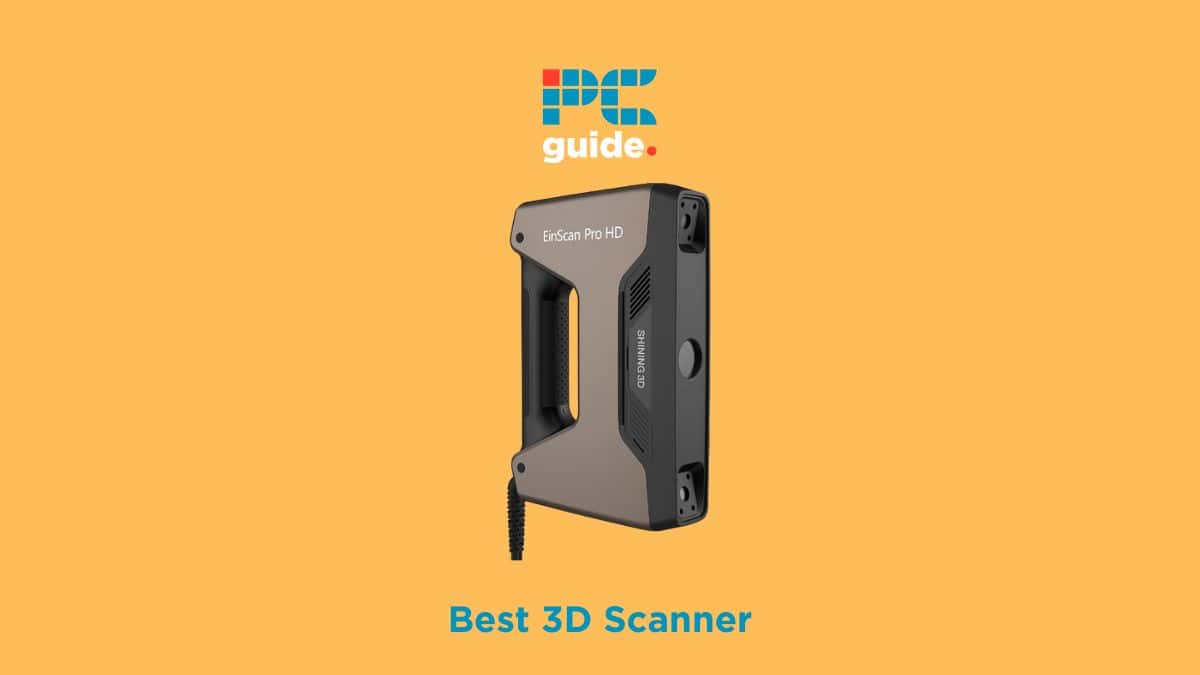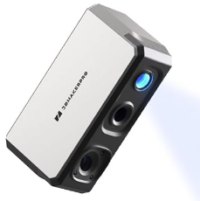Best 3D Scanner in 2025: Start digitizing the real world today

Table of Contents
If you’re looking to invest in the best 3D scanner for your business or craft, you’ve come to the right place. 3D scanners have become a transformative tool in fields such as architecture, entertainment, and healthcare; and enable you to digitize objects with high levels of detail. Though it may seem far-fetched, the best 3D scanners aren’t all premium-priced models, and there are plenty of options for a range of budgets and specialist needs.
To save you time, we’ve put together our recommendations for 3D scanners across the market, covering a range of prices and preferences for the models. So regardless of your business or household’s situation, you’ll find the best 3D scanner for you!
Products at a Glance
How We Picked the Best 3D Scanner
3D scanners are complex and multi-faceted tools, but the base elements that comprise them are generally the same. The best 3D scanners are the most precise ones: capable of creating detailed high-poly scans of objects even in direct sunlight or other non-ideal conditions. They should also have pinpoint-accurate color clarity and texture mapping, and work quickly with a high scanning framerate.
Though it’s hard to find a 3D scanner with all the best features at a reasonable price, our choices today work to straddle the line between price and quality, to provide the best results from both. In addition, we have selected both a budget-friendly and beginner-friendly option for those just getting to grips with 3D scanning.
Product Reviews
- High scanning speed
- Structured light scanning
- Easy to use
- Premium price
For the ultimate scanning solution, the EinScan Pro HD is the best 3D scanner on the market. Coming with everything you need to scan with confidence, this premium option provides stunning quality and clarity across a range of applications.
While most accurate scanners on the market use laser triangulation, the EinScan Pro HD uses structured light technology, which offers accuracy in most situations whilst incorporating texture mapping and color capturing. Whereas normally you’d have to choose between the two, you get the best of both with this 3D scanner. You also get a gamut of other features, including mesh editing support to fill in potential gaps, and a scan speed between 1,500,000 and 3,000,000 points per second. The ExScan Pro companion software is highly user-friendly and quick to master.
We’re thankful for this, as the EinScan Pro HD comes with an eye-watering price tag attached. The overall accuracy of the model can vary too, from an unnoticeable 0.045mm through to 0.3mm depending on the scanning mode used – so be sure to check your settings before scanning. These are both manageable flaws, however, and the EinScan Pro HD is still our pick for the best 3D scanner!
- Affordable
- Reduced shadow interference
- Limited accuracy
If you’re new to 3D scanning and want something relatively affordable with straightforward controls and software, the Revopoint POP 3 is for you. Considering the features you receive at this price point, it’s a tremendous choice to last you through the beginner stages of 3D scanning.
What makes this our best beginner 3D scanner is all the accessories that come in the box: we highly recommend spending a little extra on the “Advanced” package, which comes with all the cables, cases, and stands of the standard scanner along with a compact turntable for quick and easy 360-degree scanning. Dual LEDs remove errors caused by shadows, enabling the depth cameras to better visualize whatever model is being scanned. This scanner excels at full-color and texture mapping, and the scanner software it comes with is quick to grow accustomed to.
However, the POP 3 isn’t the most accurate 3D scanner on the market, with an intermediate accuracy of 0.5 mm and a speed of 12-18FPS. This is to be expected, though, and the value-for-money on display with the Revopoint POP 3 is still exceptional and well worth a look from a beginner to the 3D scanning world!
- Affordable
- Great build quality
- Full-color scanning
- Poor accuracy
If you’re a student who can’t afford a high-end 3D scanner or don’t want to break the bank over something you’ll only use occasionally, then going for a budget-friendly option like the Creality CR-Scan Ferret is your best bet. Even though it’s cheaper than most scanners on the market, it’s still an excellent value for your money, considering its depth and breadth of features.
One thing that jumps out from this budget 3D scanner is the build quality: it’s impressively sturdy and durable for a low-end model – whilst still being light enough to carry. We’re a big fan of Creality 3D printers, and it’s encouraging to see their affordable quality carry over to the scanners. You can choose between a number of scanning settings, including automated and freehand scanning, and the CR-Scan Ferret comes with several add-ons in the box including a phone stand and tripod.
In spite of having decent scan speeds, the overall resolution isn’t as accurate, at only 0.1mm. Still, for full-color scanning at a low price point, the Creality CR-Scan Ferret is an ideal choice!
- Highly accurate
- Reasonable price
- Great color accuracy
- Slow speeds
Continuing with the animal-themed 3D scanner names, we have the 3DMakerpro Seal. Though it isn’t as cheap as the Ferret, this handheld 3D scanner offers the best accuracy of any product on our list.
Say you’re an engineer digitizing micro-detailed models, or you work in Quality Control and require precision when verifying dimensions – if accuracy is the priority, then the Seal has got you covered. With an accuracy of 0.01 mm, it is easily the most precise scanner on our list. And it doesn’t stop there: the Seal has a 24-bit color camera that does a fantastic job with color-capturing, as well as an anti-shake optical lens that ensures optimal accuracy. At a median price between the best and beginner units, this is a great mid-range 3D scanner with near-unrivaled accuracy.
That accuracy does come with a downside, however. In using structured light instead of laser triangulation, the precision comes at the cost of scanning speed. While scanners have speeds of 15-30FPS on average, the Seal 3D only offers 10FPS. This tradeoff may be too much for some, but we think it’s reasonable for the unmatched accuracy that the 3DMakerpro Seal offers!
- Highly portable
- Decent speed and accuracy
- Limited scan size
Our final option is the Matter & Form Mfs1V2, a highly-portable unit that earns its spot on this ranking of the best 3D scanners. If your work requires constantly traveling from one location to another, hauling a cumbersome 3D scanner around can be quite a hassle – a problem you won’t have with this unit.
The V2 MSF1V2 was made with small to medium-sized objects in mind, as it has a small, built-in automatic turntable with a diameter of 6.2″. Once you’re done using it, the V2 MSF1V2’s external frame swiftly folds into a small suitcase that can carry its add-ons. With a standard scan accuracy of 0.1mm at 20FPS, this comfortable sits at the midde-ground of the 3D scanner market. For quicker, less accurate scans, use the dedicated QuickScan mode to scan geometric shapes in as little as 65 seconds.
They’ll have to be small shapes, however: the portability of this 3D scanner limits the size of objects you can scan, which can be frustrating for anything above medium-sized. However, for general 3D scanning on the go, the Mfs1V2 is an ideal solution!
Features and Considerations
If you’re looking for a scanner of your own, then consider the following before buying:
Scanner Types
The most common technologies used in 3D scanners are laser triangulation and structured light. Depending on your needs, you can determine which technology you need according to its advantages. Laser triangulation determines the 3D coordinates of objects using trigonometric principles. It reflects a laser beam off the object’s surface into a camera that measures the beam’s angle. It’s highly accurate, but isn’t as suitable for reflective surfaces. On the other hand, structured light projects a pattern on your object and measures its coordinates depending on how the pattern distorts. It won’t provide accurate measurements on tiny objects, but it’s fast, has good color capturing, and is better at scanning large objects.
Speed
For optimized efficiency, ensure that your scanner is capable of keeping up with your workload. Most 3D scanners come with a mode that allows you to sacrifice overall quality for speed, but the scanner should run quickly regardless.
Accuracy
Choosing your suitable accuracy depends on what you intend to use the scanner for. For instance, precision won’t be your top priority if you use the scanner for educational or training purposes since your goal will be to teach concepts rather than provide exact measurements. On the other hand, if you work in architectural design, manufacturing, or engineering, you’ll require an especially accurate 3D scanner for a precise digital representation of your objects.
Resolution
While accuracy refers to how closely the 3D model will match your physical object’s measurements, resolution indicates the level of detail your scanner can show on the digital representation. Depending on your field of work, a scanner that isn’t accurate but has high resolution may be for you. For example, in artistic applications such as animation, you don’t need exact measurements, but clarity is crucial. Resolution is measured in dots per inch (DPI), and generally, a 3D scanner with around 600 DPI will be sufficient for most uses.
Portability
Portability is arguably the most important feature of a 3D scanner if your work requires constantly transporting your equipment. Most 3D scanners are handheld in some capacity, but be sure to double-check that yours is suited to your travel needs.
Color Clarity
While traditional 3D scanners focus more on capturing shapes and sizes, some artistic fields will benefit from a color-capturing feature. This is useful across a number of formats, allowing you to better distinguish different elements of the scanned object.
Texture Mapping
In some applications, capturing shapes, sizes, and colors may not be sufficient, which is when you should consider buying a scanner with texture mapping. This is where your scanner maps small bumps, indentations, and shades to create a 2D textured layer to sit on top of your 3D model. If what the scanned object is made of is as important as its shape, be sure to invest in a scanner capable of texture mapping.
Scanner Software
Like many traditional document scanners, 3D scanners come with dedicated drivers that enable you to properly utilize the scanners. Most of these are suitably reliable, but the best 3D scanner software options are highly compatible and easy-to-use for beginners. As a baseline, make sure your 3D scanner software enables you to export the scan in your preferred format.
Do I need a 3D scanner for 3D printing?
3D scanners make it possible to duplicate real-world objects into digital copies, which can then be printed using a 3D printer. They aren’t essential, but they are highly valuable.
What's the difference between accuracy and resolution for 3D scanners?
Accuracy is technical and refers to how closely the digital illustration’s measurements and proportions emulate your object. Resolution is more cosmetic, and it shows the level of detail at which your object is displayed digitally. A digital object can have high accuracy but low resolution, and vice versa.
Our Verdict
Though its price could buy you several budget options, the EinScan Pro HD delivers on its promise for highly accurate and top-resolution 3D scanning! Suitable for everything from animation to archival, this premium 3D scanner is a surefire way to create incredible digital models with ease!
For digitizing more traditional 2D images, why not check out our guide on the best slide scanners for 35mm film?




